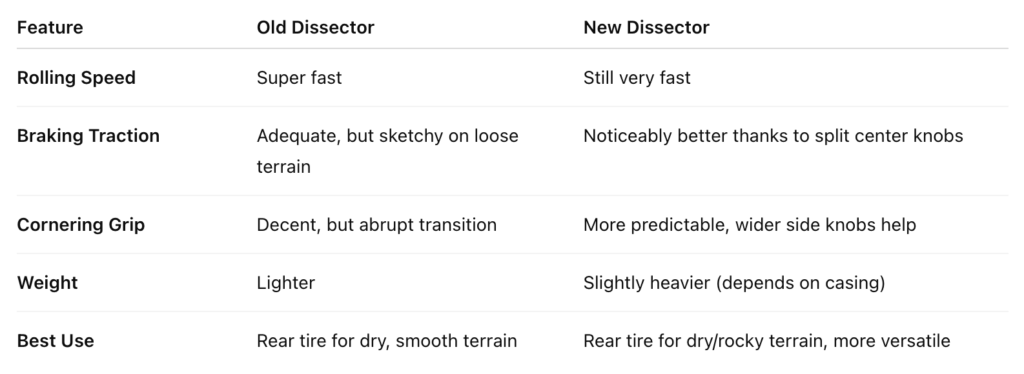The Maxxis Dissector has built a reputation as one of the fastest rolling aggressive MTB tires out there. Originally designed with Troy Brosnan, it struck a balance: speed on dry, fast terrain without totally sacrificing control. But Maxxis recently updated the Dissector, and riders are asking: what’s actually different? Let’s break down old vs. new.
The Original Dissector (V1)
The first Dissector was a favourite for dry, hardpack, and bike park laps. Key traits:
-
Fast-rolling center tread – 2-3-2 knob pattern kept drag low.
-
Minimal braking bite – quick on smooth ground, but under hard braking it sometimes felt vague.
-
Cornering grip – decent side knobs, but some riders found a “light switch” transition between center and edge.
-
Best placement – worked great as a rear tire for aggressive trail and enduro, or as a front in super-dry hardpack.
The trade-off? Speed over outright traction. In loose or wet conditions, it could feel sketchy compared to a Minion DHR II.
The New Dissector (V2)
Maxxis didn’t reinvent the tire — they refined it. The new Dissector keeps the fast DNA but fixes some weak spots:
-
Wider side knobs – More rubber on the ground = better bite in corners.
-
Re-shaped transition knobs – Smoother, less “all-or-nothing” lean feel.
-
Split center knobs – Adds braking traction without killing speed.
-
Same 2-3-2 pattern – Keeps rolling resistance low.
-
Slightly heavier – Depending on casing, ~40g more in some versions.
The result is a tire that still rips on fast terrain, but feels more predictable and planted when the trail gets rough.
Side-by-Side: Old vs. New
Which One Should You Run?
-
Pick the Old Dissector if… you’re all about speed, ride mostly hardpack or bike park lines, and don’t mind trading some grip for efficiency.
-
Pick the New Dissector if… you want a faster-rolling rear tire that still gives you confidence braking and cornering when things get rowdy.
For most riders, the new version is the better all-rounder. It keeps the speed that made the Dissector famous, but adds just enough bite to feel safer when the trail isn’t perfect.
Final Take
The Maxxis Dissector didn’t need a total overhaul — it just needed a few tweaks. The new version smooths out the rough edges, literally, making it one of the best “fast rear tire” options in the Maxxis lineup. If you loved the old one, you’ll feel right at home. If you avoided it because it felt sketchy, the update is worth a second look.
You can shop our full selection of mountain bike tires here. Remember that we offer free shipping on all orders over $149CAD. Orders are all processed and shipped within 24 business hours as well.
Spend less and ride the best with TBS Bike Parts.
Related Articles
HOW TO CHOOSE THE RIGHT MOUNTAIN BIKE TIRE
MAXXIS EXO VS. EXO+ – WHAT’S THE DIFFERENCE?
MAXXIS DOUBLEDOWN VS. DH CASING – WHAT’S THE DIFFERENCE?
TIPS & TRICKS FOR INSTALLING TUBELESS MTB TIRES
MAXXIS MTB TIRE MODELS – WHICH ONE IS RIGHT FOR YOU?
MTB TUBES VS. TUBELESS – ADVANTAGES AND DISADVANTAGES
MAXXGRIP VS. MAXXTERRA – WHAT’S THE DIFFERENCE?
MAXXIS (NEW EXO+) VS (OLD EXO+) – WHAT’S THE DIFFERENCE
5 REASONS YOU SHOULD USE TUBELESS MTB INSERTS
MTB TIRE SIDEWALL CRACKING: WHAT CAUSES IT & HOW TO PREVENT IT






